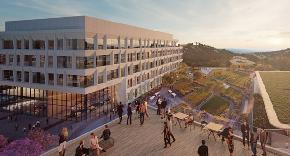 Posthumus: “If interest rates jump up to 6%, it will be hard for a lot of buyers to qualify for loans, and they may look at leasing versus purchasing, which could slow down the market a little bit.”
Posthumus: “If interest rates jump up to 6%, it will be hard for a lot of buyers to qualify for loans, and they may look at leasing versus purchasing, which could slow down the market a little bit.”
SAN DIEGO—Particularly in the I-15 corridor, the San Diego industrial owner/user market has surpassed peak pricing, there’s a void of smaller buildings and rapidly growing smaller businesses are increasing demand, Colliers International VP Marc Posthumus tells GlobeSt.com. That makes now an especially good time for these owner/users to sell.
According to the firm, average owner/user sales reached $196 per square foot in 2017; 2008’s peak was $190 per square foot. That market could be near a tipping point, similar to the 2008 trend. Also, climbing interest rates could affect building values.
The lack of smaller buildings is also a concern, with no new construction of buildings 25,000 square feet and under since 2007/2008. This product size comprises only 1% of buildings for sale in the I-15 corridor. We also have the lowest industrial vacancy rates ever recorded countywide.
Also, smaller businesses have been increasing demand in this market. For example, Ickler Electric purchased a 34,655-square-foot property to consolidate its growing electrical business into one campus, and Mascot Factory purchased a 10,500-square-foot building to expand its business of storage and distribution of stuffed animals for college mascots.
We spoke with Posthumus about how owner/users are viewing the market and what their options might be.
GlobeSt.com: Do you think that more owners will begin to sell their industrial properties based on these market fundamentals?
Posthumus: I think getting the word out there has helped to get more product on the market. We have done a lot of targeted marketing to the I-15 corridor to let them know now would be a good time to sell. But it usually depends on other factors: an outgrown building—which, in an expanding market, is great because they want to expand into something else, and that will result in another transaction—or a change in partnership where they want to realign ownership. It’s usually some kind of change like that that triggers it.
But in general, it’s a very tight market and hard to find product. There are only three buildings for sale under 25,000 square feet in the I-15 corridor right now, and that’s less than 1% of the buildings available for sale in the market. To get the word out, we’ve let people know we’re at a tipping point now. It took us 10 years to get to this peak level of pricing, and interest rates are up about 1% from where they were from 1.5 years ago—they gradually crept up. They’re closer to 5% in a 25-year fixed now than the 4% they were at a year-and-a-half ago. If interest rates jump up to 6%, it will be hard for a lot of buyers to qualify for loans, and they may look at leasing versus purchasing, which could slow down the market a little bit.
GlobeSt.com: How might those seeking to buy industrial properties find them in such a scarce market?
Posthumus: That’s really the challenge. We work with a number of buyers who are frustrated because they can’t find anything to buy. They will switch brokers hoping another will be able to dig things up. That’s where working with an expert in an area is valuable—those who know about off-market properties. There are so many people chasing those buildings.
GlobeSt.com: How likely are buyers to be able to apply adaptive reuse to convert properties to industrial—especially since last-mile industrial properties are in such great need now?
Posthumus: I would say the industrial side of things defects the least to adaptive reuse. It’s the simplest form of commercial property. We see a ton of that on the office side of things, where developers go in and repurpose outdated properties, but on the industrial side of things, when it’s a simple box, it’s a little bit harder. But we are seeing people taking advantage of refacing and rebranding this type of product type. We’re seeing the big-box retail not needed as much and companies like Amazon buying warehouses to stockpile inventory rather than having inventory in the store.
Also continuing is the fact that no product is available for sale. Everybody wants to buy industrial because it’s the safest form of real estate to own: there’s low risk. not much turnover or retrofitting costs, whereas with office buildings, when a tenant moves out, you need to reposition them with Title 24 requirements such as LED lighting. Industrial is a popular product type—there’s a limited supply of land in California, and for the land that is available, the economies of scale really take small buildings out of the equation for development. There’s some vacant land in Poway, but it’s owned by those who only can pencil with 60,000-square-foot to 80,000-square-foot buildings—that’s not competitive for the smaller guys who want to own a 10,000-square-foot to 20,000-square-foot building.
GlobeSt.com: What else should our readers know about the industrial-investment sector?
Posthumus: Interest rates are rising, so it’s important to touch base with an SBA lender. The Feds anticipate increased rates sometime this year.

















 Copyright © 2024 ALM Global, LLC. All Rights Reserved.
Copyright © 2024 ALM Global, LLC. All Rights Reserved.